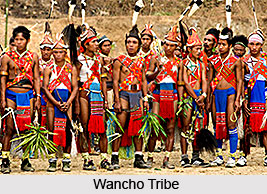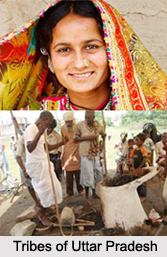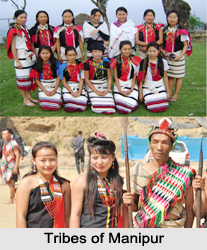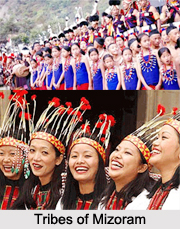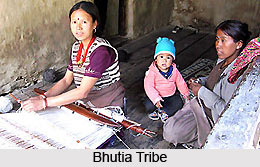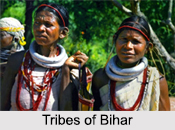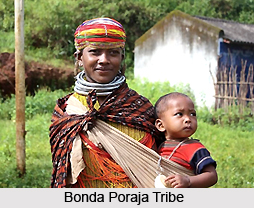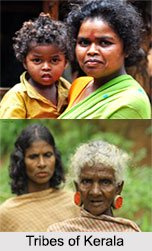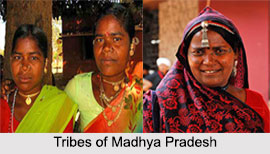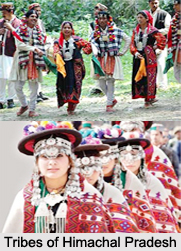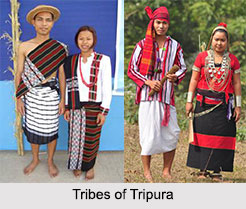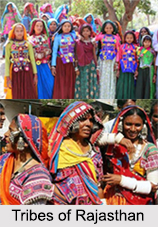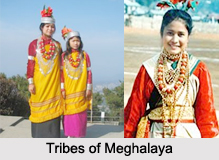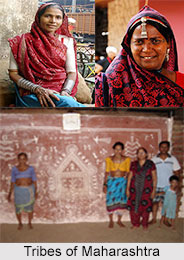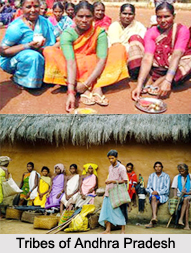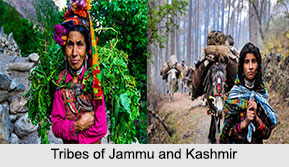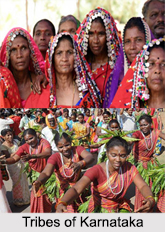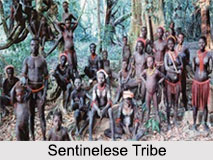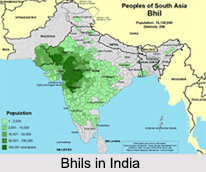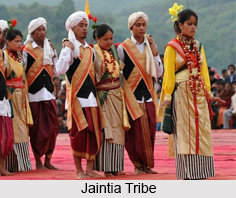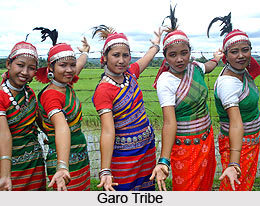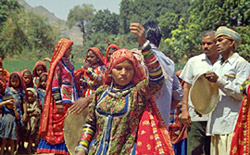Introduction
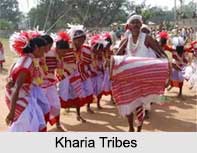 Kharia Tribes have occupied a major portion of the rugged slopes of Ranchi, Lohardaga and the furrowed incline of west and east Singhbhum and Hazaribagh of the Jharkhand. Although the Kharia tribes have mainly concentrated in Jharkhand, yet they can also be found in Odisha and West Bengal in little number.
Kharia Tribes have occupied a major portion of the rugged slopes of Ranchi, Lohardaga and the furrowed incline of west and east Singhbhum and Hazaribagh of the Jharkhand. Although the Kharia tribes have mainly concentrated in Jharkhand, yet they can also be found in Odisha and West Bengal in little number.
Origin of Kharia Tribe
As per the ancient history of the Kharias, they are the descendants of Nagvanshi Raja, Munda. Being a part of the `Proto-Austroloid` family group, the language of the Kharia tribes are known as Kharia language. These Kharia tribes also speak languages like Sadani, Hindi language and few other dialects that have originated locally.
Society of Kharia Tribe
The Kharia tribal society is segregated in to three broad segments namely the Dudh, Dhelki and Hill Kharia. The Hill Kharia is most ancient community. Amongst them also, there is wide prevalence of clan system. Popular clans of Kharia are Badya, Gulgu, Bhuiya, Jaru, Tesa and Hembrom etc.
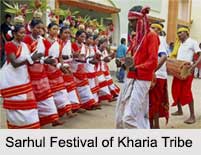 Family is the core of social set up in the society of Kharia tribal communities. Most of the families of this tribe are nuclear. The Kharia tribes adapt to partlineal, patrilocal and patriarchal family.
Family is the core of social set up in the society of Kharia tribal communities. Most of the families of this tribe are nuclear. The Kharia tribes adapt to partlineal, patrilocal and patriarchal family.
Marriage is an important institution. Although the Kharia society is monogamous polygamy is widely prevalent. The religious head of the Dhelki Kharias and Dudh are called Pahan and the Hill Kharias call their religious head Dihuri. This is a post which one holds on a hereditary basis.
Occupation of Kharia Tribe
The major source of livelihood for the Kharia tribe is agriculture. Some of them also depend on small forest products like roots, seeds, flowers, edible herbs, leaves, fruits, wax, honey, etc. Fishing, hunting as well as animal husbandry is exercised as supplementary occupations. They cultivate crops like maize, vegetables and bean etc. Apart from these the Kharia people also grow brinjal, lady`s finger, tomato, bean, potato, peas, etc. in their lands.
Religion of Kharia Tribe
The religion of Kharia Tribe is a blend of the beliefs and rituals of Hinduism, tribalism and Christianity. They worship the deities of Nag Deo, Jal Deo, Gram Deo, Dharati Mai, Burn Deo, Thakur Deo, Fire God, Burha-Burhi Deo etc. and the spirits. Burha Burhi or Marsi Masan is the progenitor of Kharia tribes whom also these Kharia tribes worship and also are respected. Sometimes they offer sacrifice to their deities to appease them.
Festivals of Kharia Tribe
A lot of local festivals and occasions are also celebrated by the people of the Kharia tribal community. Just like other tribes of Jharkhand, these Kharia tribes celebrate festivals like Karma, Sohrai, Sarhul, Nawakhani, Ramnavami, Dussehra, Diwali etc. Dance and music are an important part of their festivals and occasions. They use Kartal, Dhol, Nagara, flute, etc during their musical performances. During their tribal dance whistling and clapping also serve as rhythmic tune.
Marriage of Kharia Tribe
Marriage of Kharia Tribe is considered to be sacred ritual associated with a series of interesting customs and performances. Several forms of marriage are associated with the Kharias but the major sacred performances are associated with Mangni Biah or Asali Biah (regular marriage).
Gojhung Sagodna or Gojhung dechho (Omen reading) and jungjungdae (Betrothal)
After the selection of a suitable bride, the family members of the groom visit the bride`s house for betrothal (jung jung dae). During their journey they mark any omen that might cross their path, the good omen being; a bear, a leopard, a corpse, a deer, a tiger, a pot full of water, a cow or a bullock while bad omen are sheep, empty pot, Nilgai (portex, pictus), a Jakal, a snake running across the path in front of the party, an animal being killed or quartered, sweepings of the house being thrown away and a dry branch falling from a tree. The Kharia reject or postpone the negotiation if they come across a bad omen as it is believed that it may result into unsuccessful marriage.
Cham Chhori Ceremony
This ceremony is celebrated for those who have undergone the Chambandhi ceremony during their childhood. Members representing at least three clans are required to be present during the ceremony. According to prevailing custom, the child during his childhood days is sold to the Lohar and during Cham Chhori ceremony he is obtained back before he is married.
For the performance of Cham Chhori, the services of the same Lohra or a member of his family is obligatory. A mora (bundle) of paddy is established in the courtyard for the bride or the groom to sit on it. The appointed Lohra chants a mantra while tying and untying the Cham (leather cord) around the neck of the boy or girl for seven times. As per the ritual he bathes the boy or girl and offers a new cloth. The Cham is then discarded and the Lohra receives his remuneration in kind.
The boy/girl seated in the courtyard facing the eastern side is surrounded by the Kutumbhs (relatives) who places a Lota (pot) of water with turmeric, a copper coin, a few leaves of Tuhi (Basil plant) and mango twig. For the occasion a small heap of arwa rice is placed in front of them while a white hen is sacrificed.
A Khrtaha i.e. the senior most relative offers worship to the Sun, Moon and Earth Gods. The white hen is allowed to pick some grains of arwa rice from the heap and is then sacrificed in the name of Ponomosor. Its blood is then dropped in the Lota. The meat of the sacrificed hen is cooked; its head along with Tapan-golang are offered to Ponomosor while the left part is distributed among the members present during the rituals. At boy or the girl at the end distributes rice beer among all the relatives assembled there
.
The family members of the bride welcome the relatives of the groom upon their arrival. The hair of the groom is oiled and combed by the groom`s mother. In one hand she holds his hair and in the other carries a cupped mango leaf containing sesame oil which is poured down the tuft of hair to notify its direction of flow. It the oil flows downward in a straight line it is believed that the couple will lead a happy and prosperous life. However, it is thought to be an omen if the flow get scattered. This performance is repeated thrice till it flows in a straight line.
The following day Paisari puja is performed by the Kalo at the dera of the bride`s party. The puja is observed for the welfare of the bride`s party. The bride and groom, well dressed and decked for the puja, are carried on arms to the Marwa. Following a brief dance the bride and the groom arrive at the chhamra khunto where they sit side by side on a mat facing the eastern side. They are accompanied by five Kharia males who remain inside the Marwa screened with clothes. This group includes the two married couples representing both the parties. The members outside the screen perform certain magical practices round the Marwa with axes and swords to ward off evil spirits.
The oil test is again performed by the members parting the bride`s hair by a mango leaf. The members present pour sesame oil from a cup over the parted hair and examine the direction in which the oil flows. It is desirable that the oil flows down towards the middle of the chest otherwise it is believed that the marriage may become unsuccessful. The procedure is repeated until oil flows in the correct direction. Unmarried young men and maidens extract the oil from sesame seeds to be used for the ceremony.
In another ceremony celebrated during the marriage, a Silaut i.e. a curry stone with turmeric, arwa rice and a bundle of thatching grass placed on it is used. The bride facing the rising sun stands over the curry stone with her heels touching the grass bundle while the groom stands over the plough behind her facing east and touching the bride`s heels with his toes. The officiant on the side of the bride`s party holds the left little finger of the groom and dips it in vermilion. A red mark is put on the forehead of the bride, parting of her hair. Similarly the officiant on the groom`s side holds the bride`s left little finger and makes a red mark on the bridegroom`s chest. The ritual is known as Sindur dan (giving of vermilion). Water is sprinkled by a Panch with mango twigs from the two pitchers, first on the couple and then all around shouting mantras and names of the Lord. All the members present also accompany him in reciting the mantras.
The groom then returns home with the bride where the later prepares rice in a new earthen pot, fetching water from a nearby tank. The food cooked for the first time by the bride is offered to the ancestral spirits by the groom along with rice beer. The couple together pray to the ancestral spirits for their happy and prosperous wedded life. They also pray to them to accept the cooked food prepared by his wife.
A widow marriage is however, performed in the bride`s house. The married couple upon returning to the grooms place undergoes a ceremonial purification by drinking a sanctifying mixture made of a few drops of blood of a white cock sacrificed in the name of the Sun God, mixed with pounded turmeric and water.
Birth Rituals of Kharia Tribe
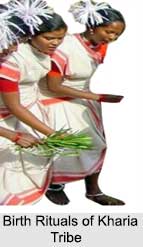 Birth Rituals of Kharia tribe is associated with the execution of several rituals, customs and practises performed after the birth of the child. The chief aim backing the performance of birth ceremony is to inculcate certain basic values in the new born child when he is still in his ignorant stage.
Birth Rituals of Kharia tribe is associated with the execution of several rituals, customs and practises performed after the birth of the child. The chief aim backing the performance of birth ceremony is to inculcate certain basic values in the new born child when he is still in his ignorant stage.
Pre-Birth Rituals of Kharia Tribe
The sacred ceremony of Dorho-jo-dom i.e. expelling the Dorho or Darha spirit from a woman is performed by the Kharia tribe when a woman conceives for the first time. The ceremony is also practised when a woman gets a still born child or experiences successive abortions or even losses children during infancy.
Several fascinating rituals are also observed by the Kharias during delivery or in case of labour pain. The Kharias open all the closed objects like door, locks, lids of boxes and corks of bottles during labour case with the belief that it would magically open the mouth of the uterus. The ceremony performed either by a Mati or a Kalo also serves the purpose of relieving the pregnant woman of the Kiri, a vow that she might have taken earlier neither from her father-in-law, mother-in-law or husband. The ceremony is celebrated with the purpose of relieving the woman of delivery pain. A small heap of arwa rice touched by an egg in way that the egg picks up some rice grains forms an important part of the ceremony. He then breaks the egg on the rice heap and sprinkles water on it using mango twigs. Upon sprinkling water on the pregnant woman, the articles used for the ceremony are thrown on the road. The Kharias believe that the performance of the ceremony would discard the vow on the road and thus, depart from the woman.
Another sacred ceremony closely related to the birth of the child is the performance of certain rituals during the loss of children in infancy. The economic condition of the family however, determines the practise of the ceremony. An affluent family performs the ceremony of chambandhi, a thread made of dried intestinal portion of a cow that is tied by a member representing the Lohra community around the neck of the newly born baby. It is strongly believed by the Kharia that the performance of this ceremony would guard the baby against all evil spirit. Later as the child grows up, the sacred ritual of Cham Utarna (thread cutting) is performed during marriage. The family may also perform the ceremony of Gendura fakura i.e. throwing on cow dung heap. During the ceremony the mother places her baby on a cow dung heap. The Kusrain also known as the midwife immediately picks it up and `sells` it to the mother at a nominal price. This ceremony is performed to ward off the evil spirit.
Shudhom (Purification Ceremony)
The Kharias perform the Shudhom i.e. the purification ceremony usually on the seventh day after birth of the child. The celebration is marked by cleaning of the house as well as the village. The mother with her baby accompanied by other female members of the family takes bath in a nearby pond or tank. Prior to taking bath the mother puts five vermillion marks on a stone lying at the water sources. The female members then bow down and offer worship to the Ponomosor, praying for the good health of the baby and the mother. Upon returning home, rice beverage is sprinkled all over the house before it is consumed by the members of the family.
Mundan (Tonsure Ceremony)
The Mundan ceremony or the first hair tonsure is performed during the afternoon time on the day on which Shudhom is performed. The mundan is executed by the maternal uncle of the baby in the courtyard of the house. The ceremony can also be performed by any male member of the mother`s side of the family in the absence of maternal uncle. As per the rituals the hair of the child is thrown over the bamboo shoot. It is commonly believed that it would enable a rapid growth of the hair of the child. The mother and her child are presented with new yellow clothes from maternal side. Prior to the commencement of the ceremony a leaf cup containing a handful of paddy is placed before the baby, deemed to the first gift from the father`s side. The paddy at the end of the ceremony is kept aside and later sown in a separate field during the rainy season. The product is however, never sold and it goes on multiplying until the baby grows up.
Chhatti and Nimi Raina (Name giving Ceremony)
The name giving ceremony is performed by the family members of the new born child after the Mundan ceremony. The Kalo who presides over the ceremony prepares a thread wear of seven strands and offers prayers to the Sun and Moon, requesting them to take care of the welfare and health of the family and the child.
Kanbedhi or Lutur-Tebki (ear boring ceremony)
The Kanbedhi ceremony also known as Lutur-tebki is performed within a span of one year after the performance of the Chhatti ceremony. The date for the celebration of the ear boring is fixed during the morning on the day following either the Bandai or Nawakhani. During the morning hours of the appointed day the Kalo performs the Paisari Puja at the courtyard of the house of the child. The ceremony is performed for the wellbeing of the relatives as well as the child. The child to undergo the ceremony is bathed early in the morning and dressed in new clothes. The Mitta or the mother`s father usually performs the ear boring of the child who is seated on the lap of his father in the courtyard, facing the east direction. The child is marked by Lukui grass or Siar punchh grass on the lower lobe of the ears by the powdered arwa rice. A Lorka i.e. a copper needle, utilized for piercing the ear lobes of the child, is twisted in the shape of rings on the ears. A small amount of powdered rice or chewed Urid (horse bean) pulse is immediately applied over the wound. The ceremony is followed by offering Tapan Golang to Ponomosor and ancestral spirits by the father of the baby.
Vivi-Tofna or Hair Tying
Vivi-Tofna or Hair Tying is performed by the Kharias when the child attains the age of 10 years. The Mitta of the child, endowed with the responsibility of performing the rituals, brings with him a string made of Sabai grass and golang rice beer. The child takes bath early morning and is then seated on a mat in the courtyard before the officiant who rubs oil over the child`s head and combs the hair with a raw bamboo comb. The comb is then kept hanged on the back of the child. A cup is filled in with rice beer into which a sting is dropped. The officiant then waves the sting below the head of the child. The process is repeated seven times. Finally, the hair gathered is tied into a knot. A piece of new cloth is used as turban in case of a boy and in case of a girl, it is wrapped around her body. The officiant presiding over the ceremony offers Tapan Golang to Ponomosor and the ancestral spirits, praying to safe guard the hair of the child from being affected by any disease.
Death Rituals of Kharia Tribe
Death rituals of Kharia Tribe are mostly related to adherence and observation of specific rites and customs. For the Kharias death and disease are not natural phenomena; deemed to be caused by annoyance or malignancy of supernatural beings or spirits. A Deonra (spirit doctor), usually called upon when a patient is on death bed, places a wick on a handful of arwa rice and a little oil in an earthen lamp. A small amount of rice is placed on a winnowing fan while the Deonra chants mantras to appease the spirits. The sick man is cured if the spirit is appeased but death occurs if he fails to please it.
After death, the dead body is covered with a kafan and placed on a bier. A deonra and few men and women carry it to the Marghati (burial place). A winnowing fan containing Khana Dhan (paddy and maso or phaseoleus Roxburghii), small earthen pot containing oil, empty pitcher and some unbleached cotton are few of the important items essential for the death rituals. When a corpse departs from the house, a man closes the door of the room where the corpse had been lying spreading some ash on the floor.
The bearers take the corpse five times around the six feet long grave before placing it near the pit with its head towards the west. The womenfolk wash the head of the corpse with water, anoint it with oil and offer coins. Finally a husband or son in case of a woman, the son or brother in case of a man or a father in case of a child anoints oil mixed with powdered turmeric on the face of the corpse and later washes it with water. The corpse is then finally placed inside the grave. A piece of cloth of the deceased is kept for ceremonial use. The Deonra then lights a bundle of grass handing it over it to the Kama who places it inside the grave. The ritual of Matti dena i.e. throwing of five handfuls of earth into the grave is observed by the other members present during the ceremony. Few ornaments or utensils may also be thrown into the grave. A Mandra (a long reed) grass is planted on the head side of the corpse that is later pulled out during covering the pit with mud, so as to leave a narrow hole in it. After the grave is covered, a female relative fetches water in an earthen pot placing it by the head side of the grave along with small earthenware containing oil and an anargi (tooth-brush). The earthen pots are perforated so as to enable the content to flow down. Before finally departing from the burial ground one of the members stroke at a huge tree with a stick and addresses it as the guardian of the deceased.
Jibsong (First purification)
This sacred ritual is performed in case of natural deaths to eradicate fish taboo from the deceased`s family. The ceremony can be performed on the same day after the burial or on the day of kamawan (final purification). The people proceed to the river, tank or stream after the burial to take bath carrying with them a small amount of oil. One of the members catches a crab or fish, or both, while bathing. The part of the cloth of the deceased kept during the time of burial is soaked in water and is carried along with fish or crab to the deceased`s house. Upon arriving at the house the fish and the turmeric water is sprinkled all over to remove death pollution. A mixture is then prepared using water, cow dung, a Birni root or some tender grass shoots and the powder made out of fish and crab and is later sprinkled on the people Two small pits are dug and filled with water in the courtyard of the deceased`s house. A wick is made from the torn off cloth of the deceased that is later lit from the earthen lamp and established by the side of one of the pits. A Sian or Deonra performs certain rituals after which all the members excluding the deceased`s son and close relatives drink Sang-sangdea (turmeric water) and become free from death pollution.
Pejo-yona (Offering of daily meal to the deceased)
Until Tiljung is performed, the Kharia offers share of their daily meals to the deceased as it is believed that the spirit of the deceased searches of his/her house. Hence, if not appeased it might cause harm to the family. Thus, a portion of the food prepared is kept aside in a leaf cup at about hundred yards from the house on the road leading to the grave.
Longoe-di-bharna or Chhai-Bhitrana
This ceremony is performed during the death of a married adult. The rituals may be observed on the same night following the burial or on a later date. On the appointed day all the earthen cooking pots are discarded and the metal utensils are thoroughly washed. The ceremony is performed at about eight O` clock in the night. The house is smeared with cow dung by the elderly women of the family who then fetches a winnowing fan full of ash, spreading it over the smeared place. A group of males of the village march towards the north-east or north-west corner of the village carrying an earthen pot, four keund sticks, one egg, two sickles, and one Sal (Shorea-nobusta) leaf cup lamp having four corners for wicks. A lamp is lit upon arriving at the spot and the three keund sticks are tied together to form a tripod stand to support the earthen pot. The pot is then covered by a Sal leaf and bound by a cloth. A series of rituals are pursued after which they all return to the village.
Tiljang (final purification ceremony)
It is the final purificatory ceremony performed on the tenth day after the death of a person. On this day the house is smeared with cow dung and the earthen cooking pots in use are discarded. The family members and the guests assemble in the courtyard where the Paisari puja is performed by the Kalo to protect the guests from the attack of Chhitta, Ghardeota and Khunt Pat.
The family members and the guests proceed towards an anthill with Mati-Deonra (witch doctor) who carries with him a magical winnowing fan, arwa rice, lamp, five fowls and an axe. The Deonra facing the eastern side rubs his left hand on his magical winnowing fan containing rice and rapidly chants mantras. Five small heaps of rice is placed before the broken ant-hill. A white cock is made to pick up a few grains at the first heap of rice before its head is severed and offered to the Dharam. Its head is dropped on the first rice heap and the trunk is thrown aside. A red fowl is also sacrificed in the name of the spirit of the deceased following the same method. The blood is procured in a leaf cup and poured on the ant-hill. The third fowl is then sacrificed in the name of the spirits believed to be the companions of the deceased while the fourth spotted cock is sacrificed in a the name of Deonra`s familiar spirit. Finally, the black cock is sacrificed in the name of Khunt Pat spirit. After the commencement of the rituals the relatives take small amount of rice from the magical winnowing fan of the Deonra and place them within the hollow space of the broken ant hill. After the execution of few other rituals the members partaking in the ritual depart for bathing and assemble at the courtyard of the deceased`s house. The head of the sacrificed fowls are then cooked by the Deonra and consumed.
The Deonra then marches towards the room death took place to sprinkle some rice-beer procured in a leaf cup in the name of the deceased. The Deonra as the spokesman of the community ultimately instructs the family members to resume eating of meat from that day.
Deities of Kharia Tribe
Worship of the spirit is the root of religion of the Kharia Tribe. Sprits, both benevolent and malevolent, are deeply worshipped and venerated during celebration of different rituals associated from birth to death. Ponomosor or Dharam, regarded as the supreme power by the Kharias, clings to the first position in the endless list of spirits that dominate every custom and family. The hierarchy of sprits is dependent on the degree of beneficent attributes and thus, the Ponomosor acquires the highest rank by all the Kharias. Darha Ahir-Ahirin, Baghaut Mua, Churil mua, Dubu mua, Giral mua, Pasal mua are some of the spirits placed at the bottom in the hierarchy list. The benevolent spirits are prayed devotedly and evoked either by an individual or the community as a whole. However, the malevolent spirits are the source of fear and terror to the community.
Ponomosor
Ponomosor or Bhagwan is the benevolent supreme power of the Kharia Tribe revered by every member of the community. Believed to protect the village from all evils, the spirit is evoked by the people during crisis period. The Kharia regard Sun (Bero) and its rays (giving) as the symbol of Ponomosor (Ibid).
Burha Burhi
The Kharia believe that after the death of a person the soul remains attached to his original abode and thus, resides with his family in the form of a spirit, showering love and affection on his relatives. The ancestral spirit is thus, treated respectfully and worshipped by his family members. A male ancestral spirit is known as Burha while the female ancestral spirit as Burhi. The Kharias each day offer these benevolent spirits a morsel of food before a meal. Every Kharia kitchen consists of a corner set apart for the permanent abode of the ancestral spirits.
Besides, on special occasions or festive period the ancestral spirits are worshipped and sacrifices are made. As per Kharia rituals the first fruit and first crop of the season is offered to them. Libation of a few drops of rice beer before consuming it also constitutes a customary ritual. Prayers offered to these spirits are believed to grant them relief from all sorts of sufferings and miseries.
Pat
Pat is the communal or village spirit that is thought to reside in hilly areas of the village. The spirit, considered as a benevolent sprit, is revered and worshipped to protect the village from calamities. The Pat is regarded as the guardian spirit who alerts the villagers of any mistakes committed or religious lapses on their part. The Kharia also name it as Pat Raja, as it is believed to have two orderlies with him; one a beast, i.e. tiger and the other, darkness.
Other Village Deities and Spirits
Besides these, the Kharias also believe in and worship few other village deities and spirits thought to possesses power and significant influence over the lives and community members.
Raksha-Dubo
The Kharia also worship other village spirits known as Pats and Hants with their leader named as Darha-Dubo (the gatekeeper spirit), also sometime known as Raksha-Dubo (the protective spirit). The leader spirit is deemed to guard the village from other impish spirits. This spirit is also some time known as Raksha-Darha or Asur-Darah.
Dharti Mai
Dharti Mai is a female benevolent spirit responsible for agricultural productions. The spirit is propitiated during various agricultural ceremonies. She is regarded as mother Earth Goddess reverenced by all the members of the community.
Mahadan
Mahadan is a benevolent spirit prayed when an epidemic breaks in the community. Kharias residing in the outskirts of the village settlement offer sacrifice in the name of this spirit. Mahadan is represented by a typical large stone of the shape of a lid.
Baranda
Baranda is regarded as the Bhayad Bhut i.e. clean spirit known to protect and safe guard the community from miseries and catastrophes. The Kharia propitiate and offer sacrifice in the name of Baranda. The spirit is represented by a carved wooden post. The families of the same clan residing within same geographical area offer sacrifice when they are disturbed or harmed by the spirit.
Khunt-Pat or Khunt-Daut
The Khunt-Pat or Khunt-Daut encompasses several spirits in their group. The Khunt is the collective name given by the Kharia to all the spirits of the dead Kharias of a village who are not included among the ancestral spirits. The Pat on the other hand notifies the spirits of rocks and hills of the village and its neighbourhood. The Dant refers to the `stem of a tree` that includes the tree-spirits or jungle spirits. The group also embraces Darha, Baghia, Churil and Mua or the Man Masans i.e. the spirits of deceased ancestors or any other deceased member of the family whose shades were not brought back ceremonially to the house due to the manner of their death. Sacrifices of fowl, goat or pig of varying colours are executed in the name of these spirits during any occasion. The spirits are also propitiated on individual level during emergency situations. These spirits are confined to particular places in the settlement that are marked by a stone or a tree.
Ahir Ahirin
The Kharia tribes have been residing with several ethnic groups for centuries. With some they developed enmity. When their enemies died, their spirits tried to cause harm to the Kharia people. Ahir and Ahirin are regarded as the spirit of such enemies that are worshipped to keep them appeased.
Baghaut Mua
Baghaut Mua is the spirit of a person killed by a tiger, thought to harm the community and injure its residents. It is thus, a malevolent spirit. The word Baghuat means tiger while mua means spirit of the killed person.
Churil Mua
Churil Mua is said to be the spirit of deceased pregnant women thought to cause harm to the community members. It specially affects the infants of the village and also injures a child in the womb. The villagers thus, worship it to appease the spirit.
Bhula
It is a malevolent spirit of the Kharias that is believed to cause discomfort and misguide them from the right path during their journey in the jungle or at an unknown place.
Chor Deva
This spirit is thought to cause great loss by robbing the Kharias of their prosperity. When harvest does not generate good production it is deemed to be affected by the Chor deva. Hence, to counteract its effect, cow dung along with small bundle of straw are placed over the heaps of paddy during the time of harvesting.
Apart from these there are a few other malevolent spirits that can be listed under the group of Khunt spirits. Among them are the spirits of dead people, whose death is caused by snake bite, falling from a tree, drowning in the water, or by any unnatural mean.
Villages of Kharia Tribe
The Kharia Tribe, occupying a large part of Ranchi, Lohardaga, East Singhbhum and Hazaribagh of the Jharkhand, comprise three tribes, the Dudh Kharia, Dhelki Kharia, and Hill Kharia. The largest concentration of the Kharia is found in Jharkhand but they can also be found in Orissa and West Bengal. In Jharkhand, these tribal groups concentrate in some of the villages such as Umra, Jhikirma, Jamadohar and Katukona and others.
Umra
Umra, a village in Palkot Tehsil in Gumla District in Jharkhand, is located at a distance of almost 16 kms from Gumla town on Gumla -Simdega road. The village has been divided into seven hamlets and has a total number of almost 121 Saonsar Kharia families. Umra proper is not resided by any Kharia population. It is inhabited by the Oraon (1 family), Suri (5 families), Binjhia (4 families), Bhokta (6 families), Ahir (28 families), Brahmin (1 family), Gossain (2 families) and Nai Thakur (1 family). The second hamlet known as Tilaidih encompasses 36 families of Kharia, while the other ethnic groups consists of Lohra (6 families), Gor (6 families), Bania (2 families) and Ghanshi (1 family). The third hamlet Thekra toli encompasses 25 families of the Kharias and the other ethnic group consists of only Bania (3 families). The fourth hamlet is Nacti toli resided by Telis (35 families). Beritoli is the fifth hamlet having only 40 families of the Kharia Tribe. The sixth hamlet, known as Madho toil, is resided by 20 families of the Kharia and 2 families of Bhoktas. The seventh hamlet known as Nava toli, has only the Lohra (4 families) and Ahir (1 family). These hamlets are located within a distance of one furlong to one and a half kilometers from Umra proper.
Jhikirma
Jhikirma, a village located in Palkot Tehsil in Gumla District in Jharkhand, is located at a distance of only 22 kilometers from Gumla town on Gumla-Simdega road. The village spread over a huge area consists of 12 hamlets viz. the Jhikirma proper, Porha toli, Doma toli, Manjha toli, Chatakpur, Dipa toli, Kabra toli, Jitiya toli, Das toli, Hazari toli, Dongrapahar and Dahu toli. Of these hamlets, Kharia families were found to reside in seven hamlets. Jhikirma proper has 13 Kharia families, while the Oraon (2 families), the Kumhar (2 families) and the Chick-Baraik (1 family) are the other ethnic groups inhabiting this hamlet. Porha toli comprises of 5 families of the Kharia. The distance between the two hamlets is more than one kilometer.
Jamadohar
Jamadohar, located in the district of Gumla in Jharkhand, is under Simdega Block and is at a distance of 13 kilometers from Simdega town on Simdega-Rengari Road. The village is primarily inhabited by the Lutheran Christian Kharias. It comprises of a total number of 7 Catholic Kharia families, 54 Lutheran Kharia and consists of 5 hamlets; Jamadohar proper or Girja toli, Naru toli, Tangar toli, Bhandar toli and Sorai toil. Jamadohar proper encompasses only fourteen families of the Lutheran Kharia while Tangar toli and Naru toli consists of 20 families and 3 families of the Lutheran Kharias respectively. 7 families of the Roman Catholic Christian Kharia reside in Sorai toli while Bhandar toli is inhabited by 17 families of the Lutheran Kharias. Besides, Munda (4 families), the Raotia (3 families), the Gond (3 families), the Mohemdan (1 family) and the Panjabi (1 family), are the other ethnic groups inhabiting the hamlet. The distance between the main village and the other varies from one to two furlongs.
Katukona
Katukona is a small village in Simdega Tehsil in Simdega District in Jharkhand, located at a distance of 14 kilometres from Simdega town on Simdega-Rengari Road. The village is primarily a Catholic Kharia Village having a total number of 38 Catholic Kharia tribes, 3 Lutheran Kharias families. The village consists of eight hamlets namely, Katukona proper or Girja toli, Naru toli, Kamal toli, Mawa toli Barka toli Tangtang toli, Dogaith toli and Lalka toli. Girja toli has 11 families of the Catholic Kharias. Besides, 4 families of the Oraon also reside here. Narutoli encompasses 2 families of the Catholic Kharias and 1 family of the Lutheran Kharias. Kamal toli consists of 7 families of the Kharia of which 5 families are Catholics while 2 families are Lutherans. 4 families of the Catholic Kharia reside in Nawa toil while 13 families of Catholic Kharias and6 families of the Rantia inhabit in Barka toil. Tangar toli consists of 3 families of the Catholic Kharia, 2 families of the Catholic Oraon and one family of the Lohra. Dongaith toli encompasses two families of the Catholic Oraon and 5 families of Dongait, also named as `Jhora`. Lalika toli incorporates 1 family each of the Chik Braik and the Dongait.
Besides, the above mentioned four villages of Jharkhand, the Kharia tribes are also found to reside in a number of other villages of the Palkot, Gumla, Sisai, Simdega Basia, Kolebira and other areas of Ranchi district viz. Simdega itself, Ramrekha (Simdega Block), Biru (Simdega Block), Longa (Basia Block), Karanj (Bharno Block), Tarri (Gumla Block), Dhedhauli (Gumla Block), Sogra (Sisai Block), Rerwa (Sisai Block), Kusum toli (Sisai Block) and Bano (Kolebira Block).
Chhatti Ceremony of Kharia Tribe
The Chhatti Ceremony or Nimi Raina also known as the name giving ceremony is celebrated by the Kharia Tribe after a span of one week of the Mundan ceremony. The ceremony highlights several significant rituals deeply interwoven into the age old Kharia customs and traditions. As per the rituals on the appointed day the adult members of the family excluding the unmarried men and women observe fast. The guests invited for the ceremony in the forenoon usually present the child with rice beer, rice or several other items of food. The Kalo or any senior member who presides over the ceremony sits facing the eastern side and prepares a thread wear comprising of seven strands. He also collects some items such as a copper coin, arwa rice and water in a leaf cup and water in a leaf cup, required for the performance of the ceremony. During the commencement of the ceremony two leaf cups containing arwa rice and a copper coin in one and water in another are placed before the performer.
The Kalo offering worship to the Sun and Moon chants the following mantra:
"O Sun and Moon (witness god) please witness, the name-giving and chhatti ceremony of the son or daughter of such and such person. Please see that the boy/girl does not have to face any misery in his/her life. Select the name of the boy/girl which you like most."
Next, the Kalo taking a one grain of rice named as Sakhi (witness) places it in a leaf cup filled with water in the name of Ponomosor. Taking another rice grain, he puts it in the water in the name of the day on which the baby was born. According to the custom if this grain floats on and meets the Sakhi grain, the name of that day is selected as the name of the baby. However, if the second rice grain sinks another grain is put in the water in the name of deceased ancestors one by one as per the sex of the child until the grain floats and connects with the Sakhi grain. Following the selection of the name of the child the residual rice in the leaf cup are pored in the water of the leaf cup. The thread prepared earlier is laid in turmeric water and tied around the waist of the baby while his feet are cleansed with the residual golang of the leaf cup. Subsequently, Tapan golang is offered to the Sun god and the moon god following which the father of the baby offers Tapan golang in the name of ancestral spirits notifying them about the completion of the Chhatti and Nimi Raina ceremony of the child.
Dimtang Puja of Kharia Tribe
Dimtang Puja, an annual cultural event of the Kharia tribe, showcases the traditions and the myriad facets of their community life. `Dimtang,` a Kharia word, means cattle shed or Gohar and tung means purification. Thus, the word Dimtang Sung means purification of cattle shed. The festival being celebrated in the Hindi month of Baisakh i.e. during April-May, it is also called Baisakhi Puja. Every year the festival is celebrated in Gohar (cattle shed) on family level. It is also occasionally performed in the tanr land i.e. up land on the clan level at an interval of every three years. Such a form of tanr is usually situated at the outer region of the village settlement. The oldest clan men and the head of the family serve as the sacred specialists on clan and family levels, respectively. This ritual is practised to appease Goria Darha i.e. the cattle spirit.
History of Dimtang Puja
When the Kharias migrate from some remote places, their cattle such as cow, ox, goat, fowl and a dog named as Chaura Bhaura accompany them. These cattle especially the cows and oxes usually carry their luggage. The cows also help them in guiding their path in the dense forest. The kharias on their way halt at certain places and take rest under trees. They also at times construct huts using the branches of trees to take shelter during the nights. The cows are thus, held in high esteem by the Kharias. To commemorate the event and to honour the services rendered by the cattle, the tribals celebrate the Dimtang Puja. During the festival they create images of cow, ox and Chaura Bhaura, the dog for the purpose of worship. Nagra Mati, a special type of soil is usually used for the artistic work.
Celebration of Dimtang Puja
The Kharias celebrate the Dimtang Puja with great devotion and dedication. No special day is assigned for the celebration of the festival though it is usually performed in the month of Baisakh (April-May). On the proposed day the head of the family or the oldest man of the clan accompanied by the other male members of the family or the clan proceeds towards the place of worship where a symbolic cattle shed is constructed using Sal wood and leaves. The shed is tied with Arwa Suta i.e. new thread all round for five times. The site deemed to be sacred is smeared with cow dung and the images created by the Nagra Mati are installed on five small heaps of Arwa rice. On clan level a pig or goat is sacrificed while on family level three fowl of varying colours are sacrificed. On the family level the Rangua (red) and Mala (spotted) fowls are sacrificed in the name of Pat whereas Kashari (Grey) colour is sacrificed in the name of Burha Burhi and Goria Darha.
On the clan level, a goat or a pig is sacrificed in the name of all the Goria Darha Pat and Burha-Burhi. The goat and pig are sacrificed using an axe. The blood oozing out is then poured on the images and also on the heaps of arwa rice. Following this, the worshippers pray to the Goria darha with folded hands uttering a mantra that states
"May my cattle remain safe and sound. May no harm befall them from tiger and bear, beast and reptiles, rivulets and rivers sickness and evil eyes." Then Tapan (offering) of lice-beer is given in the name of this deity.
The head of the animal slashed is dressed and later cooked by the Kalo who cooks it and eats it alone with boiled rice. A portion of the food is sometimes shared with the unmarried sons present at the spot during the ceremony. In case of clan level celebration the flesh of the goat or pig is distributed equally among each family. Upon returning back home the meat is prepared and then jointly consumes by all the family members excluding the unmarried girls.
Pilgrimage Centres of Kharia Tribe
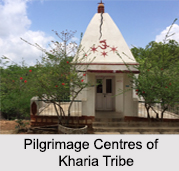 Pilgrimage Centres of Kharia Tribe pay a host to several sacred performances and religious festivals. The Kharia Tribe, coming under the influence of Hinduism and Christianity, adopted a number of sacred performances of the Hindus and the Christians and underwent major transformations that led to the development of several pilgrimage centres. Their affinity towards Hinduism also brought about significant transformations in the geography of the Kharia who espoused a number of sacred centers of the Hindus such as Ramrekha Dham, Hindu temples at Biru, Garja, Palkot and Bhaur Pahar or Tulsi Chaura, sacred places where Mahabiri Jhanda is planted during Ramnavami, Chauka of the Kabir Panthis, Devi Guri and other sacred places connected with Divine Light mission.
Pilgrimage Centres of Kharia Tribe pay a host to several sacred performances and religious festivals. The Kharia Tribe, coming under the influence of Hinduism and Christianity, adopted a number of sacred performances of the Hindus and the Christians and underwent major transformations that led to the development of several pilgrimage centres. Their affinity towards Hinduism also brought about significant transformations in the geography of the Kharia who espoused a number of sacred centers of the Hindus such as Ramrekha Dham, Hindu temples at Biru, Garja, Palkot and Bhaur Pahar or Tulsi Chaura, sacred places where Mahabiri Jhanda is planted during Ramnavami, Chauka of the Kabir Panthis, Devi Guri and other sacred places connected with Divine Light mission.
Ramrekha Dham
Ramrekha Dham, situated in a hill nearly 16 miles north-west of Simdega, is the principal pilgrimage centre of the Kharia tribe. According to local legend, Lord Rama with his holy consort Sita and brother Lakshmana spent time here during 14 years of exile. The footprints of Lord Rama and Sita is said to be preserved in Ramrekha. A cave positioned on the hill is believed to bear a close relation with the sojourn of Lord Rama. Idols of Rama, Sita and Lakshmana, Lord Krishna and Radha, Lord Jagannath and a Shivalinga are enshrined in Ramrekha. It is also a site for water-pit named as "Ramganga", said to have been excavated by Rama with the mighty stroke of his powerful arrow for bathing.
Mahabiri Jhanda
Mahabiri Jhanda planted in the community, serves as a sacred centre of the Kharias. Ramnavami, celebrated in the month of Chait Nawami, is observed in the sacred centres where Mahabiri Jhanda is planted.
Tulsi Chaura
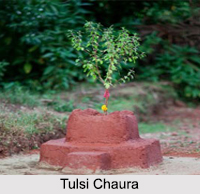 A Tulsi Chaura, set up in the courtyard of the community with a Tulsi (Basil) seedling transplanted over it, is worshiped and reverenced by the Kharia tribes. The Kharias, who borrowed the trait of preserving a Tulsi Chaura from the Hindu neighbours, can be grouped under two heads: the Bhagats, and the reconverted Christian Kharias. The Bhagats pursue the custom of their Hindu Guru, while the reconverted Christian Kharias are directed by the Mahanth of Ramrekha Dham to establish a Tulsi Chaura in their courtyard. The community members pour water on the Tulsi plant every morning after bath, chanting the Gayatri Mantra twice a day. They also lit an earthen lamp in the morning and evening in reverence. The Kharias also offer water oblation to Lord Surya in the tank, spring or river after taking bath. Such spots are thus, considered to be temporary sacred centres.
A Tulsi Chaura, set up in the courtyard of the community with a Tulsi (Basil) seedling transplanted over it, is worshiped and reverenced by the Kharia tribes. The Kharias, who borrowed the trait of preserving a Tulsi Chaura from the Hindu neighbours, can be grouped under two heads: the Bhagats, and the reconverted Christian Kharias. The Bhagats pursue the custom of their Hindu Guru, while the reconverted Christian Kharias are directed by the Mahanth of Ramrekha Dham to establish a Tulsi Chaura in their courtyard. The community members pour water on the Tulsi plant every morning after bath, chanting the Gayatri Mantra twice a day. They also lit an earthen lamp in the morning and evening in reverence. The Kharias also offer water oblation to Lord Surya in the tank, spring or river after taking bath. Such spots are thus, considered to be temporary sacred centres.
Devi Guri
The Kharias after coming into close association with the Hindus have adopted a new sacred centre known as "Devi Guri". "Devi" signifies Mother Goddess, while "Guri" means a shrine or temple of Mother goddess. Almost all the non-Christian Kharia villages have a Devi Guri of two types; one is the common Devi Guri where the Kharias and the Hindus offer worship together while the second one is found only in the houses of the Kharia Bhagats.
Within the Guri the altar is decked with 5 to 7 earthen lamps arranged in a row at the eastern side, representing Mother Goddesses like Chaturbhuji Maha Lakshmi, Chaturbhuja Malta Kali, Chaturbhuja Maha Saraswati, Shankar Parvati, Barhma Barhamani, Vishnu Laxmi and Dashbhuji Durga. These lit lamps are backed by triangular flags of varying colours like white, black, violet, yellow, green and red supported by bamboo splinters.
Kabirpanthi Chauka
The impact of Kabirpanthi, a Hindu sectarian movement, has fostered the development of sacred centres and the growth of affinity towards it. Rituals associated with several lifecycle ceremonies are performed in the Chauka that is chiefly of five types, Sahaj or Sukh or Anandi Chauka, Chalawa or Ashat Parhari or Dukh Chauka, Janam or Solah sut ka Chauka, Ekotari Chauka and Barsait Chauka. Sahaj and Chalawa Chauka are worshipped by Mahanth while the rest three are worshipped by Dharam Gurus.
Besides Ramrekha, other locations such as Biru, Garja, Palkot, Bhaurpahar, Dedhauli, Rerwa, Basudeo Kona, Nagpheni and Jambahar encompass Hindu temples dedicated to Lord Shiva and Parvati, Jagannath, Lord Vishnu, Goddess Durga, Devimai, Goddess Kali and Lord Surya. Temples enshrining the Sun God are traceable at places like Biru, Garja, Palkot, Bhaurpahar, Dedhauli, Rerwa, Basudeo Kona, Nagpheni and Jambahar.
Apart from these, the different types of sacred groves (Sarna) like Pat Sarna, Mahadan Sarna, Sarhul Sarna, Gomi Sarna, Gohul, are specific locations under trees, paddy fields in waste land in forest under hills, Rojangarha or the sacred centre in the kitchen room thought to be the abode of lineage deities. The village church is considered to be sacred centres of worship for the reconverted Christian Kharias. These Pilgrimage Centres of Kharia Tribe also host several sacred customs and rituals.
Ramrekha Dham of Kharia Tribe
Ramrekha Dham, one of the foremost pilgrimage centres of the Kharia tribe, is situated nearly sixteen miles north-west of Simdega. According to a local legend, Lord Rama along with his consort Sita and brother Lakshmana spent time here during their exile period. The pilgrimage destination thus, houses footprints of Rama and Sita and idols of Rama, Sita and Lakshmana, Krishna and Radha, Jagannath, and a Shivalinga. A water pit named Ramganga constructed near the cave is deemed to have been excavated by Rama with the powerful blow of his mighty arrow. The perennial flow of water of the deep cave is endowed with medicinal properties known to cure leprosy.
Legend of Ramrekha Dham
According to the folk legends dating back to almost two hundred years, the pilgrimage centre was visited by a milkman from Madhya Pradesh who came here in search of his missing cow. During his journey he witnessed five yogis (saints) taking bath in the Kund (water-pit) who, without enquiring directed him the accurate spot to locate his cow. The milkman assuming the sacred importance of the location and the divine powers of the saints narrated the mysterious incident to others.
The local Baiga later received a divine instruction in his dream to propitiate the sacred place. Following the orders given he identified the spot and began worshipping the sacred region installing a Shivalinga. In due course, the sacred importance of this dham attained name and recognition that helped draw the attention of hordes of pilgrims. The assistance of the Baiga Pahan was sought after for offering worship. The Baiga however, later went to Madhu Das Gosain of Paledih who again entrusted the responsibility of propitiating the deities of the dham to Sri Madhu Das Gosainjee.
Sri Hari Bhajan Dasji, the Guru Maharaj of the Raja of Jashpur State, in due course visited the Ramrekha dham. Sri Madhu Dasjee requested him to take up the responsibility of a Mahanth of this place that was readily accepted by him.
Sri Hari Bhajan Dasjee later upon meeting Sri Narain Singh, the ninth Raja of Biru Raj family was requested to visit the sacred place. He installed idols of Rama, Sita and Lakshmana and donated forty five acres of agricultural land for the maintenance of this dham. He made necessary arrangements for regular donation of paddy and money and is credited with renovating the cave and initiating construction works in the interest of the devotees of this place. Garjraj Singh, the 17th Raja further installed stone idols of Rama, Sita and Lakshmana while the 18th Raja, Sri Niwas Hukum Singh installed idols of Lord Krishna and Radha on the occasion of Rash (a play or sport of Lord Krishna) festival in the month of Kartik during October-November. He also erected a Yagyashala, a place meant for offering yagya for purification and a sacred kitchen meant for preparing prasad for the deities. The pilgrimage centre also underwent some renovation work under the patronage of the next Raja, Raja Dharamjeet Singh.
Festivals of Ramrekha Dham
The sacred pilgrimage pays host to two fairs celebrated during the month of Kartik i.e. during October-November and Magh i.e. January-February. The fairs, organised for the propagation and development of the Sanatan Dharam, catch the fancy of tribal and non-tribal participants, especially few Christian tribal converts.
Lord Rama is believed to have visited Ramrekha on the Kartik Purnimashi day. Thus, to commemorate the incident the fair is organised in the month of Kartik. The fair on the Magh Purnamashi day is organised as per the local belief that this day marks the beginning of Kali Yuga (the present mythical era).
Resonating sounds of Mahamantra chanted by Brahmin priests at the sacred center evoke interest among the devotees. Occasional Sankirtan (musical and sacred recitations), are also organized. The local Kharias residing in villages Pakar Pani, Chirobera, Rengerpani, Hardibera, Salkaya, Longapani, visit the fair to partake in dancing that prolong the whole night. Arrangements are made for devotional musical programs for which a shed is temporarily erected with images of Hindu Gods and deities, decorated with flowers. Devotees circumambulate these deities chanting sacred mantras.
Of late an Executive Committee has been formed by the Biru Raja for the maintenance of Ramrekha shrine. The reputation of Ramrekha Dham as a wish fulfilment centre draws hordes of tribals residing in Pakarpani, Hardibera, Chirobera, Lasega Diapathal, Bambolkera, Kandra, Bhinypur Kattasaru, Ramja, Taraloyia, Karayaguri and Basan. The religious and spiritual programs hosted in Ramrekha Dham helps to inculcate a sense of devotion towards the Hindu deities.
